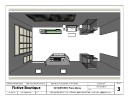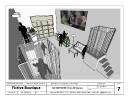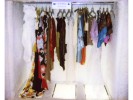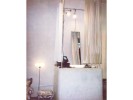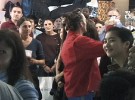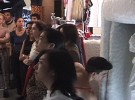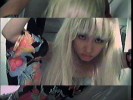Fictive Boutique, 1999
An illusory retail space and lounge environment…experience the joys of actual shopping -Â without the hassle of having to take it all home.
An art installation and set of performances at the temporary site EXPO | SURE, 242 Elizabeth Street, New York City, presented through the Downtown Arts Festival, in space created by Pompei AD for Levi’s® Vintage Clothing, festival sponsor.
Â
Design Images:
 Â
Photo Documentation of Installation:
Video Documentation Stills of Performance:
Fictive Boutique Video Stills:
Fictive Boutique Video Excerpt:
[tubepress mode=’playlist’, playlistValue=’0A1237D6EA525A5D’]
Project Description:
The idea behind Fictive Boutique was to create a fake clothing store where people could “shop” but where nothing was actually for sale – a way of provoking thought about boutique culture and the nature of shopping.
Fictive Boutique occupied the front third of a former retail space in Nolita, procured by the design firm Pompei AD, as a “Pop Up” display space showcasing New York artists. Three projects were chosen with curatorial input from the Downtown Arts festival. The DAF for 1999, and the entire Expo Sure event was sponsored by Levi’s®. The project Fictive Boutique was one of three projects chosen for the exhibit.
In addition to the fake clothing store installation, Fictive Boutique also included a series of live performances in which dancers performed a set of choreographed actions in the “dressing rooms” of the boutique and were captured by multiple video cameras. These video feeds were further manipulated by two VJs, live, in time to music from a dj, and were combined with text about the nature of shopping. A live audience watched the spectacle as it was projected onto the walls of the space.Â
A few random thoughts: As shopping has become the main form of activity in public space, boutiques in Nolita and the surrounding Downtown area have become a breeding ground for emerging culture. They have begun crossing traditional boundaries of what a store is supposed to do and be, and are creating spaces where creative people come to hang out and exchange the kind of day to day information that, through the process of accretion, actually creates positive growth and change.Â
Young designer/artists are making small numbers of items, or even one-offs, not solely as a means to generate samples, but as the actual mode of production. This low volume means low profit, especially if the clothing is priced so that like minded individuals can afford it, but the process of making what they love and controlling the content of what is produced outweighs, for them, the drive to purely do business. The argument goes “ignore everything you’re supposed to worry about and make the things you yourself want to see in the world. Opportunities will follow, allowing you to continue.â€
Along with this is a radical shift from emphasis on design to emphasis on styling. In  Tokyo a great number of contemporary street fashion mags have sprung up because kids are combining elements of clothing from so many different cultural esthetics into a single ensemble, that the process of simply reporting on new designers doesn’t reveal any of this whole alternative cultural aesthetic.
In Italy a new class of design professional- a cross between fashion researcher/color predictor and actual designer is occurring as professionals buy vintage, style it, cut, paste and modify, assign alternate colors through swatching, and then advise clothing companies all the way through the production process. They don’t do fashion sketches, and don’t have final say, yet they are essentially the original authors of the clothing’s aesthetic.
Along with this also goes a general shift from things mass produced back to an appreciation of hand crafted work. As styling begins to have similar weight to design, there is now a new process of using historically iconic, mass produced items, in association with radical craft pieces and young designer’s one-offs to create a look and make cultural statements through clothing. In the current fashion era, people aren’t so ready to let others control what there is to wear. Each individual becomes, in a way, his or her own designer.
Credits:
Conceived and Produced by: Paul Clay
Choreography: David Neumann
VJs: Paul Clay and Willyum Delirious
DJ: Hiro
Live Performance: Miho Nikaido, Terry Bartlett,
David Neumann, and Yukiko Takagi
Clothing Design: Yukiko Takagi
Interior Design: Paul Clay
Presented by:
The Downtown Arts FestivalÂ
Expo | SureÂ
Levi’S® Vintage Clothing
A Project of Fictive.Â
Construction:
Mark Power, Torsten Schneider, Toshimi , ArronÂ
Cantor, Joe Foley, Shelly McGuinness, Clement Remy, Noriko.Â
Patterns Advisor: Lise Kovar
Special Thanks:Â
Levi’s ® Vintage ClothingÂ
Ron, Alison , Michael , Lynn, Laura ,Zoe, Jonathan, Vajra, Henry,Â
Shannon, and everyone at Pompei AD.Â
Simon, Craig, and Downtown Arts ProjectsÂ
Lipe, and everyone at LANGUAGEÂ
Joe Plotkin, and Broadway.netÂ
Peter Scharff and Scharff WeisbergÂ
CovadÂ
Apple Computer
Shoes for the performance generously donated by:Â
Norman Smitherman through Suzi Funahara and Antenna 88.Â
(For more info, Contact # 212.645.0700)


